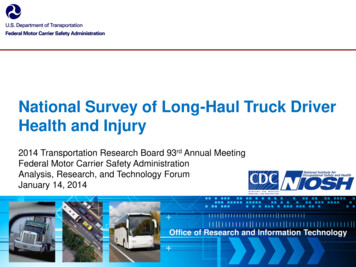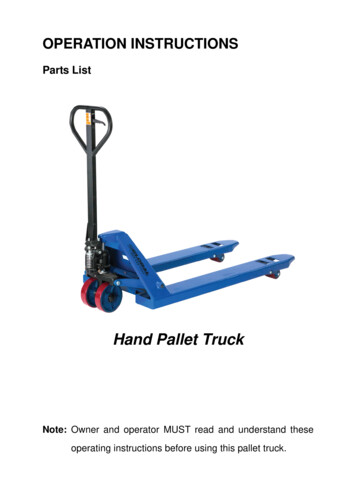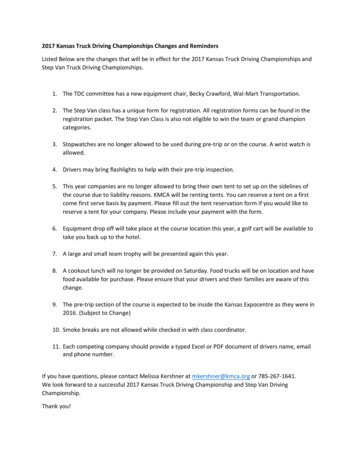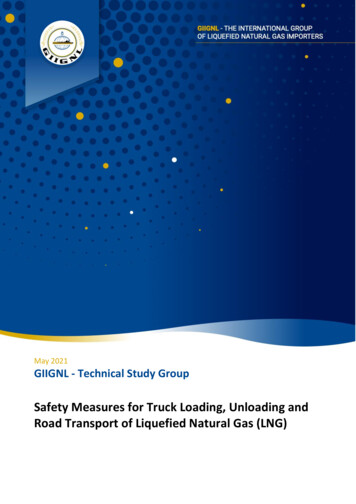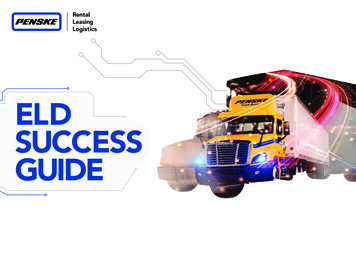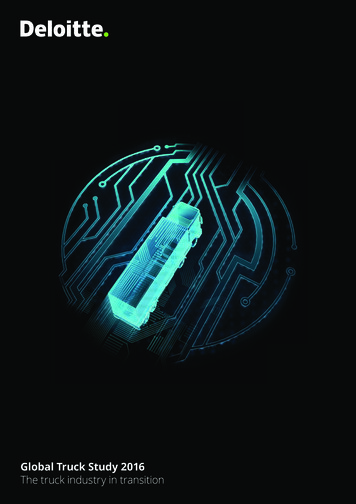
Transcription
Global Truck Study 2016The truck industry in transition
ContentsSummary03Digitalization and new logistics concepts05Growth of the global commercial vehicle industry06Trend 1: Telematics services10Trend 2: Urban logistics concepts19Trend 3: Larger fleets and sharing concepts20Trend 4: Alternative drive systems23Market outlook: growth in BRIC countries29Conclusion and recommendations36Appendix3802
Global Truck Study 2016 The truck industry in transitionSummaryDigitalization and weaker growth prospects:stagnation in the commercial vehicle marketCommercial vehicle manufacturersmust supplement their hardwarebusiness with digital servicesThe traditional idea that economic growthmeans increasing sales of trucks is breakingdown. Commercial vehicle manufacturersare expected to sell barely any more heavy(HCVs) and medium commercial (MCVs)vehicles in 2026 than they do today. Inshort, sales are likely to stagnate over thenext ten years.Although slightly higher volumes are stillanticipated in the BRIC countries, thisgrowth will be balanced against decliningtruck sales in the Triad. Telematics anddigitalization will lead to gains in efficiencyand declining demand in these highlydeveloped markets.This study predicts a compound annualgrowth rate of only 0.6% (CAGR1) for theglobal heavy and medium commercialvehicle markets until 2026. The weakgrowth prospects for the truck marketare only partially offset by subdued expectations for global economic growth(OECD 3.3% per year until 2026).Particularly in the highly developedcommercial markets of the Triad2,telematics and digitalization in transportwill enable further increases in efficiency,meaning that fewer commercial vehicleswill be required to transport the same oreven a greater number of goods. Thus, theTriad markets are expected to shrink slightly at an annual rate of -0.9% from 2016 to2021. After that, the decline is expected toaccelerate to -1.4% per year until 2026.12Despite all the current difficulties in theBRIC countries, the truck markets inthese regions are likely to offer manyopportunities and a CAGR of 1.6% until2026. Their share in the global market willincrease from 47% in 2016 to 52% in 2026.However, digitalization will also reducegrowth in the long term.Manufacturers must also prepare themselves for consolidation within the logistics sector, which will be dominated by anever-smaller number of customers withever-greater purchasing power. Alternativedrive systems will also play an importantrole in the future. New supply concepts forurban areas will also lead to many mediumcommercial vehicles being replaced by lightcommercial vehicles.The study closely examines four globaltrends that will have a lasting effect on thecommercial vehicle market. These trendswill fundamentally transform global truckmarkets. Established commercial vehiclemanufacturers will have the opportunityto actively shape this process, but to do so,they must successfully occupy new areasof business and go beyond being simplymanufacturers of products to becomehardware manufacturers with a widerange of digital services.Compound Annual Growth RateNorth America, 28 European countries, developed countries in Asia03
Global Truck Study 2016 The truck industry in transitionTrend 1,telematics services:Digitalization will be the biggest driverof change in the truck market. Telematicssystems in trucks will become standardin the Triad markets. IT and software solutions will closely integrate transporters intothe systems of the Industry 4.0 value chain.Connected devices allow dynamic routeoptimization and ensure better capacityutilization. Systems for monitoring anindividual’s driving style and wear on components save fuel, protect materials, andincreases a truck’s useful life. The resultingtelematics sales will more than triple overthe next ten years with 16% annual growth,and therefore grow much more stronglythan sales in the vehicle business. OEMsmust tap into telematics and IT servicesbusiness to stay profitable in the face ofdeclining sales volumes.Trend 2,urban logistics concepts:Increasing urbanization3 is leading tofundamental changes in supply conceptsfor major urban areas. Experts believe thatlight commercial vehicles will be increasingly used for last mile distribution in tenyears’ time – also to avoid access restrictions in urban centers. At the same time,better-controlled networks will bring distribution centers and therefore also heavycommercial vehicles closer and closer tometropolitan areas. The result will be thatmedium-sized trucks will lose a significantshare (-2% CAGR by 2026) of freight transport in the Triad to light and heavy commercial trucks. Globally speaking, themedium-sized segment will be stagnantby 2026, while MCVs will continue to be indemand, especially in structurally weak regions of the RoW and in China. At present,approximately 60% of all MCVs are usedin the transport segment. The remaining40% special-purpose vehicles such as firetrucks, concrete mixers, or sewer cleanertrucks are excluded from these trends.Trend 3,larger fleets and sharing concepts:Rising cost pressure is leading to increasedconsolidation within the logistics sector.The trend towards larger fleets with morethan 100 vehicles will continue to increaseuntil 2026. The number of customers isshrinking, while their purchasing power isgrowing. OEMs need to respond to this,for example by expanding their range ofproducts and services for large customersand strengthen their direct sales channels.OEMs must adapt their dealer networkaccordingly.Trend 4,alternative drive systems:Tighter exhaust gas regulations and accessrestrictions for diesel vehicles, especially inlarge cities, demand major investment inalternative drive systems 4, while simultaneously opening up new sales opportunities. A market model developed by Deloitteshows that about 13% of new vehicles(MCV HCV) in the key German market willalready have an alternative drive systemby 2026. In MCVs, there is a trend towardplug-in hybrids (67% vehicles will havealternative drive systems vehicles by 2026).On long distances, nearly 80% of HCVs withalternative drive systems will be running onnatural gas (LNG CNG).34UN Analysis: nearly 60% of the global population will live in cities in 2026The study evaluates the following alternative drives: PHEV: Plug-in-Hybrid Electric Vehicle, BEV: Battery ElectricVehicle, LNG/CNG: Liquid/Compressed Natural Gas04
Global Truck Study 2016 The truck industry in transitionHow will digitalization and newlogistics concepts shape thefuture of the truck industry?The very foundations of the way in whichgoods are transported in the future is setto change. Let us imagine a world in whichtrucks are connected and driving semiautonomous. New logistics concepts willtransform the world of transport. Demandfor fuel is falling and costs per trip are declining. Sophisticated safety systems nowallow the vehicles themselves to eliminatemost causes of accidents.This study addresses the followingquestions:The commercial vehicle industry is alreadydiscussing the opportunities and risks thatthese new developments open up for thesector. OEMs and suppliers are evaluatingthe possible direction a future shift in theirbusiness and the structure of the marketwill take. What role will alternative drive systemsplay for heavy and medium commercialvehicles ten years from now?The new developments not only affect thedesign and function of the truck as a product but also require greater integration ofthe truck into the entire goods transportation ecosystem. This demands a strategicreorientation of the industry.This study focuses on the main logisticstrends and the implications for the commercial vehicle markets and manufacturers who supply them. Which trends will influence truck salesfigures, if it will be possible to transportmore goods on fewer trucks in thefuture? What new skills will OEMs need to beable to compete in the commercialvehicle market of the future?The topic of autonomous driving wasdeliberately omitted from this study. Thereason for this is that it must be assumedthat driverless trucks are not expected tobe widely used within the next ten years.It is true that new assistance systems arelikely to relieve drivers of individual tasks orthe entire task of driving on some sectionsof the road, but completely doing withouta driver is not anticipated within the timeframe of this market study.05
Global Truck Study 2016 The truck industry in transitionWeak economic momentum and newtechnologies limit the growth of theglobal commercial vehicle marketsThe manufacturers of commercial vehicleswill be operating in dramatically differentmarkets within the next ten years. Whereglobal sales performance was once closelytied to economic development and the growthof the global economy, this connection israpidly disintegrating5.Growth in the global economy is alsoexpected to slow down (GDP 3.3% CAGRaccording to the OECD) through to 2026,and even weaker growth is projected forthe Triad markets. Conversely, other regionsand the BRIC countries are projected togrow at an above-average rate6.The global economy appears to be sufferingfrom increasing exporting fatigue: the globaltrading volume has fallen at a rate of 2.5%CAGR over the past five years. Further, asharp drop was recorded (12.5%) between2014 and 2015. Should this trend continue,it is likely to put negative pressure on thedemand for transport services and consequently demand for commercial vehicles.The commercial vehicle market will passthrough two phases over the next tenyears, each with its own dynamics. Annualgrowth of 1.3% is expected over the nextfive years, largely driven by continuedCAGR 1,3%Sales inunits (K)18CAGR- 0,1%3.000Global tradevolume(in trio. US )20economic growth. Increases in efficiencyresulting from innovative supply conceptswill begin taking effect from 2021 onwards,and demand for commercial vehicles willdecline. Deloitte expects negative growthof 0.1% CAGR between 2021 and 2026. Thistranslates to annual increase of 0.6% overthe entire ten-year period.CAGRin 02120262.5232.00065%101.5005100-55-100CAGRtrade volumesFigure 1: Global CV markets will be brakedout by decreasing trade volumesSource: IMF, macrobond65000-152011 2012 2013 2014 201551.000HCVMCVFigure 2: Global sales of MCV and HCV segmentsin 5-year periods (in K units)Source: IHS, Deloitte AnalysisCV sales figures: IHS, Deloitte Analysis; GDP growth: OECD long-term forecastGDP ranking 2015 to 2030: Brazil from place 7 to 6, Russia from 6 to 7, India stays on 3,China stays on 1, Indonesia from 9 to 5, Turkey from 17 to 14; Source: IMF06
Global Truck Study 2016 The truck industry in transitionHowever, there are strong regional differences: in the Triad markets, the weak economy and efficiency gains in logistics are shrinking the market ( 1.1% CAGR). By contrast,BRIC ( 1.6% CAGR) and RoW ( 1.5% CAGR)are performing significantly better. Advancing industrialization can however tobe expected to drive similar improvementsin efficiency to those experienced in highlydeveloped economies in eight to ten years.BRIC will dominate the world of truck salesin 2026. At this time these four countries,with their combined market share of 52%,will encompass more than half the globalmarket volume. Only a third of the numberof units sold will be attributable to the Triadmarkets.Sales inunits (K)3.0002.6912.5232.5002.000 18%( 210)1.50015%(368)1.000500OEMs are therefore facing weaker growthover the next ten years. The markets in theBRIC and RoW regions are indeed growingslightly, but sales figures are falling in theTriad and competitive pressure is on igure 3: Development of regional sales market sharesSource: IHS, Deloitte Analysisunits by 2026, which corresponds to a bareseven per cent across ten years. The keytrends will have an earlier and stronger effect in the highly developed Triad markets,although their influence will also increasein the BRIC markets from 2021 onwards.-480 650-3303.0002.600-11%(-104)2016Sales in units (K)2.800 17%( 62)0The impact of GDP growth and the fourkey trends on commercial vehicle salesis shown in Figure 4: under otherwiseunchanged conditions, economic growthwould lead to a plus of 650,000 units soldby 2026. This is offset by the reduction indemand due to telematics (330,000 units),urban logistics concepts (minus 90,000units) and larger fleets and sharing concepts (minus 60,000 units). Ultimately, thisleaves a sales increase of only 170,0003.20052%(1.395)47%(1.185)-90-602.5232.692 1702.400TRIADEHigh ImpactBRICMedium impactRoWLow sticconceptsLarger fleetsand sharingconcepts2026Figure 4: Impact of GDP growth and the four key trends on commercial vehicle sales (in K units)Source: IHS, Deloitte Analysis07
Global Truck Study 2016 The truck industry in transitionMajor trends and their consequences at a glanceTelematics servicesChangeEffectsUrban logistics conceptsLarger fleets and sharing concepts Real-time information about the Industry, commerce and end userscondition of the vehicle, traffic,demand increasingly more specificloading capacity, condition of cargo,transport solutions.etc. are used for optimization. More sophisticated ordering The modern truck is integrated intobehavior and rising numbers ofthe value chain.packages demand new logisticsconcepts. The total cost of ownership is further improved through telematics Increasing urbanization forcesolutions: routes are dynamicallylogistics companies’ to relocateoptimized, empty journeys avoidtheir distribution centers closer toed, truck uptime and productivityurban areas.is increased. The number of acci Distribution centers rely on HCVsdents drops dramatically.for long haul transport and LCVsfor last mile delivery to the endcustomer. The transport logistics sector continues to consolidate, resulting inincreasingly large fleets. The application of telematics solutions requires a highly developedinfrastructure and a premiumproduct; which is why demand isconcentrated in the Triad markets. Owner-driver 7 concepts will not survive the competition. Telematics solutions will becomestandard in mature markets withinthe next ten years. The telematics market will growby a factor of three in the next tenyears. MCVs will lose transport marketshares to HCVs and LCVs in theTriad markets and shrink at 1.8%CAGR until 2026. In countries with a lack of infrastructure, some regions will continue to rely on the MCV segment(BRIC: 1.5% and RoW: 0.5%CAGR). Global sales of MCVs will stagnate. Increasingly efficient networks thanksto optimized routes, less unutilized capacity and pooled transport volumesincrease total capacity. Truck sharing concepts increase andmeet peak needs more intelligentlythan existing rental models. Sharingmodels increase the overall efficiencyof the transport network. Continued trend towards consolidation and larger fleets. Rental and sharing concepts are alsoan interesting market for non-OEMs. Percentage of peak needs coveredby new sharing and rental conceptswill increase in the short term andimprove efficiency. It is not just OEMs investing in telematics -– IT companies are alsoinvesting in the development ofnew telematics services to capturemarket shares. There will be strongcompetitionExpected effecton demand- 10% truck demand(approx. 330,000 units)- 3% truck demand(approx. 90,000 units)- 2% truck demand(approx. 60,000 units)Overall effectThese factors will together reduce the growth in the truck market by 15% (approx. 480,000 units, 2016 to 2026)Figure 5: Impacts of key trends on market developmentAlternative drive systems will also gain significance in the commercial vehicle industry over the next ten years and seize marketshares from diesel. Even though this does not have any overall impact on sales figures, a projection of future market sharescan be found in Chapter 4 of this study.7Owner-drivers are commercial vehicle owners who are also drivers themselves08
The trendsin detail09
Global Truck Study 2016 The truck industry in transitionTrend 1:Telematics servicesDigitalization means major improvements in efficiency software and apps for commercial vehicles are becominga billion-dollar marketIncreasing competitive pressure is forcingfleet operators to intensify their search formeans to increase efficiency and reducecosts. Even today, many are using morethan 90 performance indicators to monitortheir vehicles, drivers and freight and optimize their processes. They are gaining further momentum from Industry 4.0concepts that integrate the modern truckmuch deeper into the value chain – also onan information technology level. New telematics solutions are enabling this connectivity within the transport chain and production landscape. Consequently, fewertrucks are needed to handle the same oreven greater transport volume.The use and functionality of telematicsservices can be split into three categories: Category 1 services monitor the entirevehicle. Category 2 services focus on the driverand safety. Category 3 services include fleet management functions and supply chainintegration.The survey of experts conducted as partof this study shows the greatest marketdemand is for services in the category offleet management and integrated supplychain. Eighty-eight percent of those interviewed perceive a great benefit in the services in this area, while the lowest level ofinterest was recorded in the vehiclemonitoring category.88% Fleet management and integrated supply chain83% Driver and safety features75% Vehicle monitoringFigure 6: Interest in application areasSource: Deloitte expert survey10
Global Truck Study 2016 The truck industry in transitionBenefitFunctionswith marketmaturity in 5 yearsVehicle monitoringDriver and safetyFleet management andintegrated supply chainOriginal functionalities forthe vehicleAdvanced functionalities forthe driver and their safetyFunctionalities for freight, capacity,ERP operations systems, etc. Less wear on the vehicle Monitoring vital status of the driver Integration into production systems Longer lifetime Takes administrative work over Increases capacity utilization Shorter standby times Fewer accidents Optimized routing Increased productivity Attractive workplace More efficient fleet use Consumption, wear and runningperformance Driving times Customized OEM solutions Speed Route optimization integrated intothe production system Real time info on fuel consumptionand suggestions for improvement Working hours Preventive maintenance message Live warnings for inappropriatedriving style Sending error codes to the repairworkshop Automatic braking and acceleration Repair workshop finder Surrounding conditions Road map updates Traffic gridlock assistant Forward-looking traffic information Remote control functions (air-conditioning, key, horn, warning light) Warning of collision Vital status of the driver Accident reports Load description in case ofaccident Track and Trace Transfer of last mile information tomobile phones Performance reports for fleet owner Load monitoring (real-time freightdata for temperature, location etc.) Electronic toll payment Platform for new insurance modelsbased on driving behavior and usage Automatic accident report /emergency call Tracker for stolen vehicle In-truck ecosystem for apps webaccessMarketmaturity in 5 years Augmented reality with windshield display of routing info Tracking of several trucks so asto drive in convoy / platooning Optimized traffic light timing andtraffic flow (communication withinfrastructure to avoid traffic jams) Direct mobile payment Environment and roadway monitoring Extended help on emergency call Automatic obstacle detection Fuel theft protection Remote truck control and parking Access to native apps and smartphone-integrated appsFigure 7: Overview of application areas and preference of Telematics services11
Limitation8%0Vehicle monitoringIn vehicle monitoring, fleet operatorsconsider preventive maintenance messagesand integrated repair services to be by farthe most important improvements. If fleetmanagers are informed of impendingtechnical problems in the vehicle, theycan plan maintenance ahead of time andthus prevent an unexpected breakdown.Integrated repair services are an optimalcomplement to these forward-thinkingmessages: error code messages can besent directly to a workshop ready formaintenance, for example, so that all thenecessary spare parts are available whenthe vehicle arrives for maintenance.Driver and safety featuresIn the drivers and safety category, thefocus lies clearly on monitoring drivingbehavior. Combined with information aboutthe route, it can be seen whether the driverhas taken advantage of all fuel-savingopportunities and driven the truck withsufficient care. Both points directly affectprofitability. If deviation in driving behaviorare detected, these can be addressed withtargeted trainings.Global Truck Study 2016 The truck industry in transition1020Fleet management services andintegrated supply chainCustomers here are particularly interestedin further improvements to route optimization. Depending on the specific task, itis worth hard cash to fleet managers, iftheir vehicles bring their cargoes to theirdestination in the shortest, the fastest, orthe most energy-saving way. Particularlyin the case of distribution services usingmedium commercial vehicles, there is alsothe possibility of dynamically adapting theorder of destinations depending on thecurrent traffic situation. Customers attachsignificantly lower, but still high importance(38%) to track-and-trace functions, whichpermit real-time localization of the vehicleand its cargo.4050607080Expert view on customer value of the categoryvehicleExpert monitoringview on customer value of the categoryfleet management servicesPreventive maintenance62%Routing optimization62%Integrated repair services54%Track and Trace38%Theft tracking15%Electronic toll paymentIntegratedentertainment systemsUse-based 050607080Expert view on customer value of the categorydriver and safety features77%Driving behavior46%Workingtime trackingDanger warning31%Emergency servicesNearly half of the fleet managers rated driving time monitoring as important; one inthree lists danger warnings that can preventaccidents and therefore damage and delaysas an important advantage.3023%Limitation8%01020304050607080Figure hethecategorycategoryExpertfleet managementvehiclemonitoring rackingElectronictoll payment15% 25%IntegratedUse-based insuranceentertainment systems15% 23%0102020304050607080Figure 10Source: Deloitte Expert SurveyExpert view on customer value of the categorydriver and safety features77%Driving behavior12Workingtime tracking46%
Global Truck Study 2016 The truck industry in transitionThe following table shows what is possible with telematics solutions today, and which applications will be possible in ten years’ time.VehiclemonitoringDriverand safetyfeaturesUse case – TodayUse case – in 10 yearsRepairing a truck beforeit breaks down: the drivergets a message as soon asa defective part needs to bereplaced and is directed tothe nearest workshop, whichalready has the part andinstalls it immediately. Predictive maintenance is alreadyreducing maintenance costs,downtime, and repairs on thevehicle.Vehicle-to-vehicle (V2V) communication willbe so advanced that platooning can be usedmore intensively, wherever the regulatoryframework permits. Platooning links at leasttwo trucks driving very close to one anotherin line. This will be a familiar sight on motorways in ten years’ time.By optimizing the timing ofmaintenance, it is possibleto reduce costs by 30% andbreakdowns by 75%8. Truckutilization has improved by3% per year in recent years.990% of accidents are attributable to humanerrors, which this can reduce to a minimum.10Today’s assistance systemssupport drivers - but theydo not replace them. Theseinclude active lane changeassistant, automatic brakingand acceleration, or collisionwarnings.From a technical perspective, fully autonomous vehicles will be close to being ready formarket in the next five years. From a legalperspective, autonomous driving at highspeed without a driver on motorways maynot be permitted before 2025.In tests, crash rates were reduced by 20% and speedingon long-haul routes by 42%.11Platooning achieves fuel savings of up to 10%because trucks drive very closely behindeach other, at a consistent speed, and withsynchronized braking and acceleration.Development will be faster in the long-haulcommercial vehicle market, as efficienciescan be realized more quickly here. Muchremains unclear from both the technical andthe legal point of view in regards to complexsituations such as urban traffic.Autonomous trucks will be greener, safer,and cheaper: they have great potential forreducing operating costs in terms of fuel,maintenance, drivers, and insurance.1289101112World Economic Forum: White Paper ”Digital Transformation of Industries”Deloitte expert Interview: “In recent years utilization increased by 3% year-on-year”Auto.de: Article "Tiredness and inattention cause most truck accidents"Federal Motor Carrier Administration: “Study of the Impact of a Telematics System”World Economic Forum: White Paper ”Digital Transformation of Industries”13
Global Truck Study 2016 The truck industry in transitionFleetmanagement services andintegratedsupplychainUse case – TodayUse case – in 10 yearsGPS and dynamic routing canbe used to avoid detours andempty journeys, and optimizethe utilization of fleets.New solutions for logistics companies withcapacity bottlenecks:Optimized routes can save5% on fuel costs13:For example, a company witha fleet of more than 1,000vehicles was able to quicklyidentify free trucks withthe help of idle alerts andoptimally adapt the routes ofall vehicles accordingly. Thisreduced the fuel consumption by 75 liters/per vehicle/month, resulting in a saving ofEUR 100,000/ month acrossthe entire fleet.Ride sharing lets companies share vehiclecapacity when they have small loads andsimilar routes. Truck sharing can be used forshort or longer truck rental periods. The advantage is that fleet operators are no longerforced to buy their own trucks, but can hirethem from an operator for short-term capacity peaks.Truck and ride sharing help fleet operatorssave the cost of an additional truck as the feeincludes the cost of repairs, insurance andadministration. The renting party only has topay fuel and driver costs.Approximately 15% of the truck market willbe using these sharing platforms by 2026.14Figure 11: Present and future possibilities of telematics services13/14World Economic Forum: White Paper ”Digital Transformation of Industries”14
Global Truck Study 2016 The truck industry in transitionTelematics solutions achieve theirfull effect only in developed markets –software offers enormous growthpotentialThe global market volume for telematicssolutions in commercial vehicles is currently around EUR 2.2 billion. Of this, 95%is attributable to hardware. In the future,this ratio will almost reverse, as hardwareis stagnating at around EUR 2 billion dueto falling costs. Meanwhile, software revenues are steadily increasing due to highervolumes. Software will reach an 80% shareof the EUR 10 billion15 telematics market in2026. Telematics currently account for 2%of the purchase price of a truck and willexpand to 8% by 2026.Salesin Billion EUR 9,9 Billion EUR109876543Software 2,3 Billion EUR2Hardware10201620182020202220242026Figure 12: Global revenue forecast of Telematic services between 2016 – 2026 (Hard- and software)15Deloitte Analysis15
Global Truck Study 2016 The truck industry in transitionIn the Triad markets, telematics hardwareis currently installed in every second truck,but software is not widely used at onlyaround 5%. Over the next few years, telematics will become standard equipment inHCV trucks in the Triad, meaning that nearlyevery new truck will be equipped with telematics by 2026. The market for retrofittingis disappearing. Penetration will be less pronounced outside the Triad and reach only80% in the MCV area by 2026, as there arefewer applications in this segment.Despite continued improvements inperformance, the cost of built-in hardwareand software will decline due to the effectsof economies of scale and technologicaladvancements. However, overall saleswill increase significantly as a result of increased distribution.Hardware2016Market penetration50%Hardware price1.400 EURSoftware services are becoming increasingly wide-ranging and powerful, meaningthat a new generation of services aboutevery five years. One of the new possibilitiesmight be the monitoring of the driver’s vitalsigns. This could enable the vehicle to safelycome to a stop in the event of health problems, while also sending immediate medicalassistance to the driver.Telematics services place heavy demandson mobile data networks, which are usuallyonly met in highly developed infrastructures.Consequently, Deloitte estimates that theTriad markets will generate about 60% oftelematics revenues in 2026. The fact thatlarge fleets in particular profit from theadvantages of telematics is another factorbehind this distribution. These are mainlyfound in mature markets.2026 50% pts.-30%100%1.000 EURSoftwareMarket penetration5%Software price500 EUR 90% pts. 200%95%1.500 EURFigure 13: Market penetration and price forecast of Telematic services (per vehicle in Triads)Source: Deloitte Analysis16
Globa
lobal Truck tudy 2016 The truck industry in transition Trend 1, telematics services: Digitalization will be the biggest driver of change in the truck market. Telematics systems in trucks will become standard in the Triad markets. IT and software solu - tions will closely integrate transporters into the systems of the Industry 4.0 value chain.


